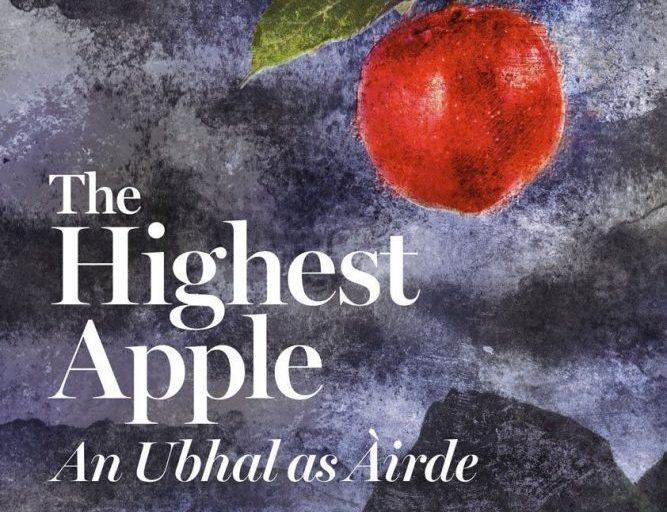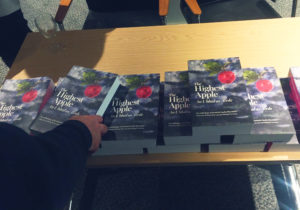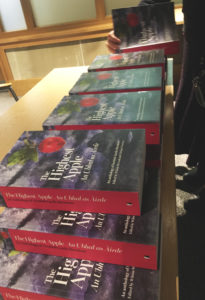Book Launch: An Ubhal as Àirde

By Sarah Scott, MSc by Research Celtic Studies
Gàidhlig
Chaidh ‘An Ubhal as Àirde’, cruinneachadh ùr de litreachas Gàidhlig, a chur air bhog air Diardaoin 14 Samhain aig an Oilthigh. Tha an leabhar na phàirt de shreath leabhraichean a sheallas farsaingeachd litreachas nam mion-chànan Eòrpach, agus tha e a’ toirt àrd-shealladh air a’ Ghàidhlig agus air co-theacsa sòisealta a’ chànain rè na 1500 bliadhnaichean a dh’fhalbh.
B’ e oidhche air leth a bh’ ann, is a’ ghealach làn a’ soillseachadh mhullaichean-taighe Dhùn Èideann air taobh muigh na h-ùinneige fhad ’s a leugh Pàdraig MacAoidh an dàn aige fhèin, ‘Tiotalan Deireannach’, a sgrìobh e às dèidh an reifreinn neo-eisimeileachd. An uair sin, thug Màrtainn Mac an t-Saoir seachad a sgeulachd ‘An t-Àite as Bòidhche fo na Neòil’ agus sheinn e an t-òran brèagha à Uibhist, ‘S ann a Bhruadair mi Raoir’.

Bhruidhinn an t-Àrd-Ollamh Wilson McLeod, a dheasaich an leabhar còmhla ri Michael Newton, agus mhìnich e gun tug e co-dhiù 10 bliadhnaichean gus an cruinneachadh a thoirt gu buil. Thogadh an leabhar air an sàr-obair a rinn sgoilearan, Ronnie Black, Dòmhnall Meek, Colm O’ Baoill agus Meg Bateman nam measg, gus litreachas Gàidhlig a thaisbeanadh agus a mhìneachadh.
Is e amas nan deasaichean farsaingeachd dualchas litreachais na Gàidhlig a riochdachadh anns an leabhar, a’ gabhail a-steach litreachas foirmeil is neo-fhoirmeil, tùrsach is aoibhneil, cràbhach is saoghalta, feargach, àbhachdail, aoireil agus drabasta; bho sgrìobhaidhean aosmhor gu litreachas ùr-nodhach, agus obraichean foghlaimte gu ‘Brochan Lom’ agus Runrig. Mar sin dheth, faodar lorg na bhroinn bàrdachd bharraichte, ach cuideachd, rosg, dràma, beul-aithris agus taghadh farsaing de sgrìobhaidhean eile, leithid òraidean, aistean agus iomraidhean air cor na Gàidhlig is nan Gàidheal.
Air sgàth a’ mhìneachaidh agus an eadar-theangachaidh Beurla a nochdas còmhla ri gach pìos, chan e a-mhàin gur e dealbh cudromach de dh’eachdraidh litreachas na Gàidhlig a th’ anns an leabhar, ach cuideachd tha e na inntrigeadh luachmhor don leughadair choitcheann. Air mo shon fhìn, is mi nam oileanach, tha an cruinneachadh seo a’ toirt sealladh farsaing dha oileanaich air litreachas agus cultar na Gàidhlig thairis air ùine – rud a dh’fhaodadh a bhith duilich dhuinn greim fhaighinn air, leis cho mòr ’s a tha an cuspair – ach cuideachd an cothrom leabhar brèagha làn de stuthan drùidhteach agus togarrach a mhealadh.
English
An Ubhal as Àirde / The Highest Apple, a new anthology of Gaelic literature, was launched on Thursday 14th November at an event at the University. The book is a contribution to a series expressing the diversity of writing in lesser-used European languages, and represents an overview of the Gaelic language and its social context over the last 1500 years.
The evening was atmospheric, with a backdrop of the bright full moon over the Edinburgh skyline as the book was brought to life by Peter MacKay, who read his poem on the aftermath of the Independence Referendum, ‘Tiotalan Deireannach’. He was followed by Martin MacIntyre, who performed part of his short story ‘An t-Àite as Bòidhche fo na Neòil’, and then sang the beautiful Uist song ’S ann a Bhruadair mi Raoir’.

The collection was presented by Professor Wilson McLeod, one of its editors, who explained that it was the result of 10 years’ effort and built on anthologies of Gaelic literature of different periods that he and colleagues such as Ronnie Black, Donald Meek, Colm O’ Baoill and Meg Bateman have produced. The aim, we heard, was to represent the Gaelic literary tradition in all its breadth – formal and informal, sorrowful and joyful, religious and secular, angry, humorous, satirical and obscene – in its oldest to its newest forms, and from the most learned to puirt à beul and Runrig. Thus the collection contains not only celebrated and familiar poetry, but also prose, drama, folk traditions, and a diverse selection of other work, such as lectures, essays and social commentary. Each contribution includes an introduction and translation into English, meaning it is not only an indispensable reflection of the history of Gaelic literature but also a valuable introduction for the general reader.
For myself, as a student, the collection allows an overview of Gaelic literature and the culture it belongs to over a long period – which is something that can be difficult for students to get a grasp of – as well as the opportunity to enjoy a beautiful book full of interesting and inspiring material.
Video
Wilson McLeod, at the book launch, tells us why this book is important. [This video is in Scottish Gaelic.]


